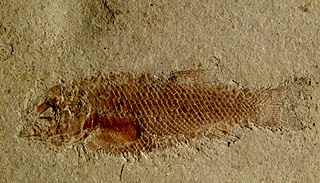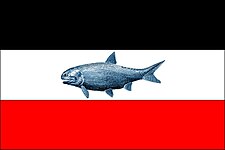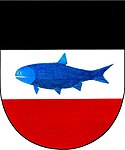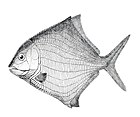
Palaeoniscum is an extinct genus of ray-finned fish from the Permian period (Guadalupian-Lopingian) of England, Germany, Turkey, North America and Greenland, and possibly other regions. The genus was named Palaeoniscum in 1818 by Henri Marie Ducrotay de Blainville, but was later misspelled as Palaeoniscus by Blainville and other authors. Palaeoniscum belongs to the family Palaeoniscidae.

Saurichthys is an extinct genus of predatory ray-finned fish from the Triassic Period. It is the type genus of the family Saurichthyidae, and the most speciose and longest lasting genus in the family. This family also includes the Permian Eosaurichthys (China) and the Jurassic Saurorhynchus from Europe and North America, though it may be more appropriate to treat these as subgenera of Saurichthys, due to the genus Saurichthys otherwise being paraphyletic.

Amblypterus is an extinct genus of ray-finned fish that lived during the Cisuralian epoch in what is now Europe and possibly India and Argentina.
Tripelta is an extinct genus of prehistoric bony fish that lived during the Anisian age in what is now New South Wales, Australia.

Pteronisculus is an extinct genus of prehistoric ray-finned fish that lived during the Early Triassic and Middle Triassic epochs of the Triassic period worldwide.
Sassenia is an extinct genus of prehistoric coelacanth lobe-finned fish that lived during the Early Triassic epoch in what is now East Greenland and Svalbard.

Acentrophorus is an extinct genus of prehistoric ray-finned fish from the Wuchiapingian of England and Germany (Kupferschiefer). There may also be a Triassic occurrence in Australia.

Aeduella is an extinct genus of prehistoric freshwater bony fish that lived during the Gzhelian and Asselian-Sakmarian ages in what is now France, Germany, Switzerland and the Czech Republik.

Boreosomus is an extinct genus of Triassic ray-finned fish. It was first described from the Arctic island of Spitsbergen, but was later also discovered in other parts of the world. The type species is Boreosomus arcticus.
Urosthenes is an extinct genus of prehistoric bony fish that lived during the Lopingian to Middle Triassic epochs in what is now New South Wales, Australia.
Gardinerichthys is an extinct genus of freshwater actinopterygian bony fish from the Cisuralian epoch of Germany, and the middle Permian of India. The type species, G. latus, was discovered in Asselian aged layers (Rotliegend).

Prohalecites is an extinct genus of ray-finned fish from the Ladinian and possibly Carnian (Triassic) of Italy. It is the oldest known teleosteomorph, a group that includes extant teleosts and their close fossil relatives.

Ptycholepiformes are an extinct order of prehistoric ray-finned fish that existed during the Triassic period and the Early Jurassic epoch. The order includes the genera Acrorhabdus, Ardoreosomus, Boreosomus, Chungkingichthys, Ptycholepis, and Yuchoulepis. Although several families have been proposed, some studies place all these genera in the same family, Ptycholepididae.

Bobasatraniiformes is an extinct order of durophagous ray-finned fish that existed from the late Permian to the Middle Triassic in both marine and freshwater environments. The order includes two families: Bobasatraniidae, with the genera Bobasatrania, Ebenaqua, and Ecrinesomus, and Dorypteridae, comprising only the genus Dorypterus (monotypy). Bobasatraniiformes had a somewhat global distribution; fossils are found in Africa (Madagascar), Asia (Pakistan), Australia, Europe, and North America.

Bourbonnella is an extinct genus of prehistoric freshwater bony fish that lived during the late Mississippian (Carboniferous) and Asselian in what is now Burgundy, Rhineland-Palatine (Germany) and the Czech Republik.

Acrolepididae is an extinct family of ray-finned fish. Genera referred to Acrolepididae existed from the Early Carboniferous period to the Early Triassic epoch. They were nektonic carnivores with a fusiform body.

Dorypterus is a small, extinct genus of prehistoric ray-finned bony fish. It lived during the Wuchiapingian stage of the late Permian epoch in what is now Germany (Kupferschiefer) and England. It is a hypsisomatic bobasatraniiform with a high dorsal fin. Due to anatomical differences with other bobasatraniiforms, such as the presence of pelvic fins and the reduced scale cover, Dorypterus is placed in its own monotypic family, Dorypteridae.
Turseodus is an extinct genus of ray-finned fish found in Late Triassic freshwater sediments of the United States. Two species have been described, T. acutus from the Lockatong Formation of Pennsylvania, and T. dolorensis from the Chinle Formation of Colorado.

Challaia is an extinct genus of prehistoric bony fish that lived during the Triassic period in what is now Argentina (Mendoza). Two species are known, C. magna, most likely from the Cerro de Las Cabras Formation, and C. elongata from the Los Rastros Formation. Three other species, C. multidentata, C. striata and C.? cacheutensis, are considered nomina dubia.

Pygopterus is an extinct genus of prehistoric bony fish that lived during the Wuchiapingian to Olenekian ages in what is now England, Germany, Greenland and Svalbard (Spitsbergen). It is one of the few genera of ray-finned fish known to cross the Permian-Triassic boundary.


























